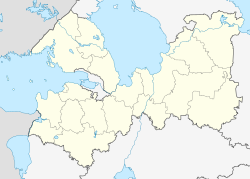Possjolok imeni Morozova
| Urban-type settlement
Possjolok imeni
Morozova Посёлок имени Морозова
|
||||||||||||||||||||||||||||||||||||
|
||||||||||||||||||||||||||||||||||||
|
||||||||||||||||||||||||||||||||||||
| List of large settlements in Russia | ||||||||||||||||||||||||||||||||||||
Possjolok imeni Morosowa ( Russian Посёлок и́мени Моро́зова ; translated Morozov settlement ) is an urban-type settlement in Leningrad Oblast ( Russia ) with 10,873 inhabitants (as of October 14, 2010).
geography
The settlement is located about 40 km east of the center of the oblast capital Saint Petersburg . It is located on the right bank of the Neva outflow from the southern end of Lake Ladoga , opposite the town of Schluesselburg .
Possjolok imeni Morosowa belongs to the Vsevoloschsky Rajon and is located a good 20 km east-southeast of its administrative center Vsevoloschsk . It is the seat of the municipality Morozovskoye gorodskoje posselenije, which also includes the five small villages Gannibalowka (3 km north), Koschkino (1.5 km east), Reswych (6 km south-west), Sheremetyevka (1.5 km south) and Chornaya Rechka (7 km southwest) and the settlement of Dunai (5 km west) belong, all with less than 40 inhabitants (2010).
history
In 1882, the construction of the Schluesselburg gunpowder factory began on lands that belonged to Baron W. von Rennenkampff . At the end of 1883 the plant started production, and in 1884 the associated settlement was founded, which was initially named after the nearby village of Sheremetyevka Sheremetyevsky zavod (Sheremetyev plant), later officially Possjolok Schlisselburgskich porochowych zavodow ("Settlement of the Schliisselburg gunpowder works").
In 1922 the plant was given the name of the revolutionary Nikolai Morosow ( Sawod imeni Morosowa; "Morosow-Werk"), while the latter was still alive , as did the settlement, which since 1927 has had the status of an urban-type settlement.
During the Second World War , on September 8, 1941 , the German Wehrmacht occupied the Schliisselburg on the other bank of the Neva, bringing Possjolok imeni Morosowa close to the front for the time of the Leningrad blockade . After the Wehrmacht was pushed back from Schluisselburg by the Red Army on January 12, 1943 and the subsequent end of the blockade, a railway line to Schluesselburg was built in a very short time and from there a temporary railway bridge was built over the Neva to Possjolok imeni Morosowa to cross the von there to supply the city with a railway line leading to Leningrad.
Population development
| year | Residents |
|---|---|
| 1926 | 4,811 |
| 1939 | 10,783 |
| 1959 | 8,936 |
| 1970 | 9,560 |
| 1979 | 11,104 |
| 1989 | 12,347 |
| 2002 | 10,677 |
| 2010 | 10,873 |
Note: census data
Attractions
In place of the Peter and Paul Church ( церковь Петра и Павла , tskerkow Petra i Pawla ) of the powder works from 1904 to 1907, a new church of the same name was built in 1993. A keeper's house of the old church from 1910 has been preserved.
At the Petrokrepost train station there is the monument Stalnoi put (“Steel Way”) in memory of the construction of the railway line to Leningrad in 1943.
On an island in the Neva at the outflow of Lake Ladoga between Possjolok imeni Morosowa and Shlisselburg lies the Oreschek fortress, founded in 1323 (1612–1702 in Swedish as Nöteborg ), which can be reached by ship from both banks of the Neva.
Economy and Infrastructure
At Possjolok imeni Morosowa there is the stop 21 km and the station Petrokrepost ("Petersfestung", name of Schluesselburg in the Soviet period from 1944) on the railway line Melnichny Rutschei (in Vsevolozhsk), which opened to Petrokrepost in 1896 and further in 1929 and electrified since 1967 - Nevskaya Dubrovka (in the Dubrovka settlement ). There is suburban train service to the Finnish train station in Saint Petersburg.
Via the regional road 41A-189 (formerly A128) the settlement is connected to the federal trunk road R21 Kola (formerly M18), which passes about 9 km to the southwest and crosses the Neva . To the north, the road continues in a wide arc around Saint Petersburg until it - on the last stretch as 41K-097 - reaches Zelenogorsk on the Gulf of Finland .
Web links
- Municipality website (Russian)
Individual evidence
- ↑ a b Itogi Vserossijskoj perepisi naselenija 2010 goda. Tom 1. Čislennostʹ i razmeščenie naselenija (Results of the All-Russian Census 2010. Volume 1. Number and distribution of the population). Tables 5 , pp. 12-209; 11 , pp. 312–979 (download from the website of the Federal Service for State Statistics of the Russian Federation)
- ↑ Church at sobory.ru (Russian)







